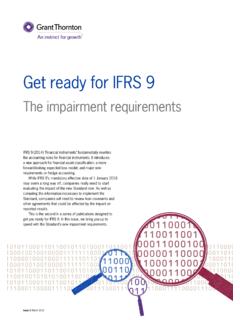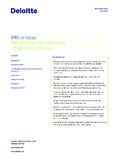Transcription of EY IFRS 9 impairment banking survey - September …
1 EY ifrs 9 impairment banking survey 2016. ifrs 9 Financial Instruments represents the most fundamental change to a financial institution's accounting methodology, risk management practices and operational processes The adoption of ifrs 9 will require significant enhancements to a financial institution's organizational engagement, data, systems, quantitative models and governance, amongst other areas. The methodology under ifrs 9 will also introduce more judgment, complexity and volatility in reporting, resulting in a need for intensive oversight and enhanced stakeholder scrutiny. Furthermore, the impact on the financial institutions' operational processes and financial reporting will not be limited to the transition period and adoption date.
2 It is expected to continue well after the implementation date of the standard (1 January 2018) due to the scale of change required by the standard and the availability of public information in the post- implementation period. In 2016, EY performed a second ifrs 9 global impairment survey and engaged 36 financial institutions to participate, including 14 global systemically important banks (G-SIBs). The survey is intended to assess the state of readiness in the implementation of the ifrs 9 program with a particular focus on impairment . This paper outlines the survey results across the global participants and provides a view on the current status of the overall ifrs 9 program, including how banks are structuring the implementation plan, decisions around critical policies within the expected credit loss methodology and the level of compliance with the Enhanced Disclosure Task Force (EDTF).
3 Recommendations. For further insights on this topic, please get in touch with the contacts provided in the appendix to this survey or your local EY contact. We would be glad to assist you if you would like to discuss the results contained in this report, including where your institution falls within the benchmarking study. Yolaine Kermarrec Andre Correia Dos Santos Page 1 EY ifrs 9 impairment banking survey 2016. Introduction EY first conducted an ifrs 9 survey in June 2015 to provide participants with a state of readiness benchmark, and to identify emerging trends in the implementation of the new standard. This second round conducted in The survey Spring 2016 captures the progress made by banks over the past nine months. All results are presented on an anonymous basis We surveyed 36 top tier ifrs -reporting financial institutions worldwide 17 have a balance sheet in excess of 600b; 9 have a balance sheet between 200b and 600b Participants 14 banks are global systemically important banks (G-SIBs).
4 Profile 15 banks are under the scope of Sarbanes-Oxley Act (SOX). 22 banks use advanced internal rating based approach (A-IRB) for all of their portfolios Banks have made significant developments in the past nine months on the implementation of their impairment program. Most banks are progressing well into the build phase in this workstream, with a focus on identifying data and system requirements in order to advance towards the deploy phase While certain impairment policy decisions are still under debate ( , multiple scenarios), we expect that participants will continue to refine their policies leading up to the parallel run as we observe greater market convergence on these topics Overall There has been some development on classification and measurement (C&M), albeit at a slower pace than state of impairment .
5 This is consistent with the relative view of complexity associated with C&M. However, banks should readiness not underestimate the ifrs 9 requirements in this area, particularly with regards to the test of solely payment of principal and interest (SPPI) for non-standardized contracts Most banks expect to start a full parallel run in Q1 2017, although some banks have had to delay this to Q2 or even Q3 in the face of slower progress than expected due to scope increases and updates to implementation guidance Most banks expect to disclose a first quantitative impact assessment to the markets during 2017. Page 2 EY ifrs 9 impairment banking survey 2016. Geographic representation of the survey participants Australia 3 Austria United Kingdom 8 1 Belgium 3.
6 Switzerland 2. 7. 2 Canada Sweden 1. Singapore 1. Italy 2 1. 1 4 Denmark Ireland Germany France 36 total number of surveyed banks Page 3 EY ifrs 9 impairment banking survey 2016. Content 1 ifrs 9 project status and governance 5 15. 2 Impact assessment 16 17. 3 Significant deterioration 18 25. 4 Definition of default 26 29. 5 Measurement of expected credit loss 30 38. 6 ifrs 9 disclosures 39. Page 4 EY ifrs 9 impairment banking survey 2016. 1. ifrs 9 project status and governance Status of impairment program Data Commentary A shift to the build phase: Policy 12 13 7 3 1 Most banks have now moved into the build phase, especially on modeling (see pages 32-36), data and systems, which banks have prioritized Disclosures 17 15 3 1 As policy and design decisions are being finalized, with certain topics under development, including multiple scenarios, most banks aim to allow flexibility for refinements Modeling 7 4 23 11 Data is widely seen as one of the major challenges of ifrs 9.
7 ifrs 9 poses numerous challenges with regards to availability (historic data at origination for stage allocation, specific Data 8 13 14 1 features for classification, external market data for measurement), granularity (for disclosures and management information), quality and storage Systems 10 13 12 1 Most banks have, therefore, started identifying data gaps early on in their programs. Most have focused their disclosure efforts on quantitative disclosures and related data points Operating model and control 21 12 21. Banks are at an early stage on designing and implementing the framework end to end target operating model: Banks are often still focused on the deployment of models to meet the immediate requirements of the standard, as opposed to delivering an end-to-end credit risk reporting solution to Design Design.
8 Build Deploy &. Live support the monthly business as usual (BAU) impairment early advanced test results production Numerous significant areas of judgment will require robust governance and control process which are transparent to auditors and external stakeholders Page 5 EY ifrs 9 impairment banking survey 2016. 1. ifrs 9 project status and governance Status of classification and measurement program Data Commentary Banks are still in the design phase for policy, BMA and SPPI: Policy 12 12 6 5 1 Efforts invested seem proportional to the impact banks expect at transition on their balance sheets, with around a quarter of banks having started bottom-up SPPI testing back to the Business model contracts assessment 9 12 5 9 1. A few banks referred to open questions remaining on technical interpretation of ifrs 9 ( , on certain prepayment options).
9 Bottom-up SPPI Banks have focused less on data, systems, operating model testing* 9 15 4 7 1. and control framework: These workstreams have a significant dependency on the Data 15 13 6 11 financial impact assessment (BMA and SPPI). Most banks are still in the process of performing a data gap analysis new data fields to track term features for BAU. Systems 14 15 6 1 governance around SPPI, market data required for the valuation of portfolios transferring to fair value through profit or loss (FVTPL), new data points for statutory and regulatory Operating model disclosure requirements and control 18 16 11. framework Embedding BMA and SPPI in BAU processes will require enhancing trade capture and new product approval processes, as well as the governance around central storage of standardized contracts.
10 Other processes impacted include Design Design Deploy &. structuring, impairment , valuation, hedge accounting and Build Live reporting early advanced test *SPPI testing back to individual contracts Page 6 EY ifrs 9 impairment banking survey 2016. 1. ifrs 9 project ifrs 9 hedge accounting Data Commentary Most banks will not apply ifrs 9 hedge accounting in 2018: As they are awaiting for further clarity and progress on the International Accounting Standards Board (IASB) macro- hedge project, and in the context of the wider cost reduction 2 agenda, banks are cautious not to spend too much, too early, 3 on their ifrs 9 hedge accounting program. This may all need 10. to change once the outcome of the macro project is known Banks also see little benefit in applying the standard, and a 3 few stated their hedging strategy is mainly macro hedging 18 New disclosure requirements: Banks are required to apply new disclosure requirements for hedge accounting from 1 January 2018 onwards, irrespective of whether they will apply ifrs 9 hedge accounting then.














